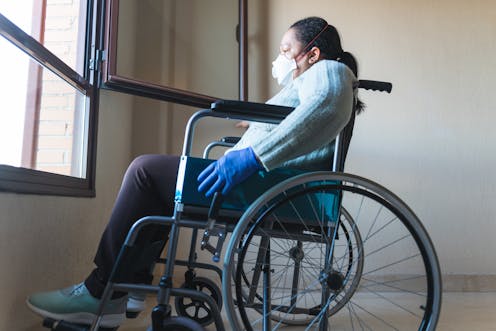
After two years of the pandemic, there is an understandable desire to “go back to normal”. Disabled people, having been particularly impacted by the pandemic, have described the removal of all COVID rules as a “kick in the teeth”.
In the UK, between January and November 2020, disabled people were up to three times more likely to die of COVID. Social care services were disrupted and in some cases, reversed. Inaccessible health briefings meant that many people were unable to get adequate information at crucial times.
The exclusion of disabled people during an international emergency is often the rule, rather than the exception. Disabled people are more likely to be abandoned during natural disasters like floods and earthquakes, and when fleeing war and conflict. They also face greater barriers to commmunication about emergencies. During the pandemic, disabled people experienced similar marginalisation and exclusion across the globe.
There is little evidence of improvements for disabled people following major emergencies, as governments often have a poor understanding of disability-specific needs. The recovery from the COVID pandemic is an opportunity to change that. Here are five things that need to happen for a disability-inclusive post-COVID world to become reality.
1. Working with disabled people
The global disability rights motto is “nothing about us without us” – meaning that decisions about policy affecting disabled people should not be made without their input. It is crucial for governments to work with disabled people and learn from their experiences when developing policies.
Organisations led by disabled people played an important role during lockdowns in helping disabled people where there was no government support. They also took a leading role in recording the impact of COVID-19 on disabled people.
Conversations about disability are still too often dominated by charities, which are usually run by non-disabled people and can perpetuate ideas about disability as “tragic”. Instead, the government needs to listen to disabled voices and work directly with them to ensure their needs and concerns are considered.
2. Address poverty
More than a quarter of families with a disabled member are in poverty. This is set to get worse during current cost of living crisis, as benefits are not rising in line with inflation, and are now at historically low levels.
Disabled people already face extra costs due to being disabled, including higher energy bills. This “disability price tag” will become unmanageable for many. It is important that disabled people, whether or not they are in work, receive adequate financial support.
This should also include funding to combat “digital poverty” – the inability to interact fully with the digital world, either because of lack of internet access, skills or finances. This is particularly acute for disabled people, who may face higher costs for accessible technology. The pandemic has shown how important technology is to remote work and social activities – ensuring all people can participate fully is an essential part of pandemic recovery.
3. Basic protection measures
As mask requirements and social distancing rules disappear, clinically vulnerable people are still at higher risk of contracting severe COVID. For example, people with learning disabilities are five times more likely to be hospitalised and eight more times to die from COVID than the average person.
Bringing back basic protection measures could reduce this risk. Mask wearing has been proven to be highly effective in stopping the spread of COVID. Requiring masks in indoor public spaces like shops or entertainment venues is a small sacrifice that could make a difference for many who are otherwise stuck at home.
Another important measure is support for people to isolate when they are sick with COVID. The current rules pressure people to go into work while sick. Both the Trades Union Congress, which represents 48 trade unions, and the human resources management association Chartered Institute of Personnel Development have called for a more effective sick pay system. These basic protection measures will help everyone, but especially disabled people, move safely towards normality.
4. Access to testing
The end of free testing presents another worry for many clinically vulnerable people, particularly disabled and older people in care homes, who are no longer eligible for free tests. The Alzheimer’s Society estimates that some care home visitors now face costs of up to £73 a month for daily lateral flow tests.

Care homes have been the hit hard by the pandemic, and visitor bans meant there was little accountability for shortcomings in the system. An international survey suggests human rights abuses took place in many countries, including the UK. Chronic understaffing and what the report called a “lack of humanity” were some of the factors that led to people dying needlessly of neglect, thirst and hunger.
Allowing visitors while keeping residents safe is crucial, but impossible without continued access to free testing.
5. Long COVID support and research funding
Long COVID, the continuing of severe symptoms that can last for months after the initial infection, is estimated to affect 1.5 million people in the UK. Yet little is currently known about its effects. Without action, long COVID has the potential to create a new generation of disabled people, with many requiring long-term treatment.
This treatment may be hard to access. Provision for other energy-limiting chronic illnesses, such as ME (Myalgic encephalomyelitis, also known as chronic fatigue syndrome) and fibromyalgia, is often poor. Stigma and misunderstandings of disability mean people with chronic illness face many barriers to accessing support.
The Trades Union Congress has called for long COVID to be recognised as a disability in the Equality Act 2010. This would provide greater legal protection by making discrimination against those with long COVID illegal and allowing them to access adjustments in the workplace.
Providing support and funding for research into long COVID is urgently needed to address the long-term health and economic risks posed by this condition.
Vera Kubenz receives funding from Arts and Humanities Research Council.
This article was originally published on The Conversation. Read the original article.







